Band gap engineering of ZnO is essential to realize low dimensional structures such as Quantum wells and super-lattices. One of the ways to engineer the band gap of ZnO is to alloy it with desired concentrations of other binary oxides such as MgO and CdO. Single wurtzite phase MgxZn1-xO alloy films with different Mg concentrations up to ~ 38% were grown by PLD to increase the band gap of ZnO. The Mg concentration in MgxZn1-xO films was obtained using energy dispersive x-ray analysis (EDAX). The band gap of MgxZn1-xO films increased monotonically from ~3.3 to 4.2 eV with increasing Mg concentration up to 38% in the films beyond which segregation of cubic phase MgO in wurtzite phase MgxZn1-xO was observed using HRXRD. Up to ~ 38% concentration of Mg, the alloy films were found to be strained but mostly single phase and c-axis oriented. The structural and optical properties of MgxZn1-xO thin films with x ≤ 32% are suitable to use them as potential barrier layers in ZnO-based quantum well structures. Further we have shown that bandgap of MgxZn1-xO films can indeed be controlled in the range of 3.45 to 3.78 eV only by changing the oxygen partial pressure in the ambient from 10-2 to 10-5 Torr using a sintered pallet of ZnO containing a fixed 10% of MgO in the target. The change in the band-gap of MgxZn1-xO films grown at different oxygen partial pressures was attributed to change in the Mg concentration in the resulting films due to scattering of PLD plume with oxygen ambient and was confirmed by EDAX measurements and Rutherford Back scattering analysis.
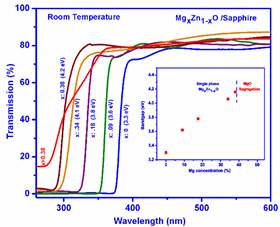 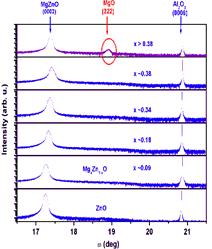
(Left) Room temperature transmittance spectra (left) and X-ray diffraction pattern (right) of MgxZn1-xO thin films with different Mg concentrations of 0, 9, 18, 34, 38 and > 38 at%. Inset shows variation of MgxZn1-xO bandgap as a function of Mg concentration, (Right) X-ray diffraction pattern of MgxZn1-xO thin films with different Mg concentrations
To reduce the ZnO bandgap we have adopted sequential ablation scheme to grow CdxZn1-xO alloy films using separate ZnO and CdO targets and achieved reduction in the ZnO band gap up to ~ 2.9 eV in predominantly single-phase CdxZn1-xO alloy films with Cd concentration up to ~8%. Sintered CdO and ZnO targets placed on a multi target carousal were ablated alternately with only one target being exposed to the laser beam at a time in a sequence. By controlling the total laser beam exposure time on the individual targets, films with different Cd compositions were grown. The optical absorption spectra of single phase MgxZn1-xO and CdxZn1-xO alloy films with different Cd concentrations are shown below wherein systematic bandgap variation with varying Mg or Cd concentrations is clearly observed.
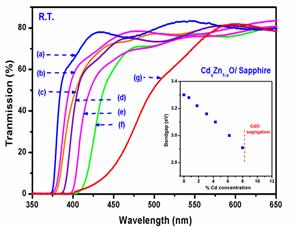 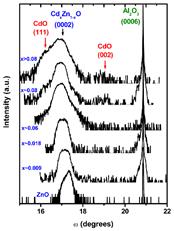
(Left) Optical transmission spectra of ZnO (a) and CdxZn1-xO thin films with (b) x~0.018 (c) x~0.031 (d) x~0.06 (e) x ~ 0.08 and (e) x > 0.08. Inset shows variation of the band gap of CdxZn1-xO thin films with varying Cd concentrations bellow CdO segregation, (Right) X-ray diffraction pattern of CdxZn1-xO thin films with different Mg concentrations
Studies on ZnO/MgZnO Heterostructures
Studies on ZnO/MgZnO Heterostructures
MgZnO/ZnO bilayers (Mg concentration of ~30%) have been grown and subsequently annealed at different temperatures in the range of 600–900 °C with the specific interest of studying the effect of inter-diffusion of Mg on the photoluminescence (PL) properties of the bilayers. The influence of Mg diffusion and material homogenization is evaluated through absorption, PL, and secondary ion mass spectrometry (SIMS) measurements. No appreciable change in the spectral positions is seen either in PL or absorption up to an annealing temperature of 700 °C, which is also supported by SIMS. However at higher annealing temperatures, diffusion of Mg into the ZnO layer is clearly evident in SIMS profile, which results in the red-shift (blue-shift) of spectral positions of MgZnO (ZnO) layer, respectively. Finally, for the sample annealed at 900 °C, the two layers are completely merged providing a single peak at ~3.60 eV in PL/absorption corresponding to a completely homogenized MgZnO layer. Spectroscopic results are corroborated by the numerical simulations based on a simple theoretical model, which correlates the observed PL spectra of the heterostructures with the experimental Mg diffusion profiles across the heterointerface, as measured by SIMS.
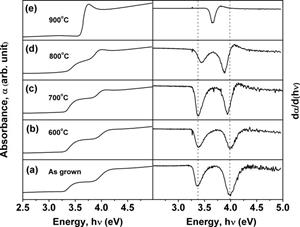 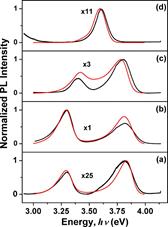
(Left) The absorption spectra and its derivative of the (a) as grown and annealed Mg0.3Zn0.7O/ZnO bilayers at (b) 600 °C, (c) 700 °C, (d) 800 °C, and (e) 900 °C, (Right) Experimental (black) and theoretical (red) PL spectra of the (a) as grown and annealed Mg0.3Zn0.7O/ZnO bilayers at (b) 700 °C, (c) 800 °C, and (d) 900 °C.
In addition to these, the detailed transport property of 2D electron gas in ZnO/MgZnO hetero-structures were studied using temperature dependent resistivity, Hall and magneto-transport measurements to understand the role of defect induced carrier scattering and weak localization effects on electrical properties of polar hetero-interface.
References:
- P. Misra et al., Variation of bandgap with oxygen pressure in MgZnO thin films grown by Pulsed Laser Deposition, Solid State Comm. 117, 2001, 673-677.
- L. M. Kukreja et al., Variable Band-gap ZnO Nanostructures Grown by Pulsed Laser Deposition, S. Barik and P. Misra, J. Crystal Growth 268 (3-4), 2004, 531-535.
- P. Misra et al., Sequential Pulsed Laser Deposition of CdxZn1-xO Alloy Thin Films for Engineering ZnO Band-gap, Appl. Phys. A, 78, 2004, 37-40.
- R. S. Ajimsha et al., Electrical and optical properties of Dy doped ZnO thin films grown by buffer assisted pulsed laser deposition, Physica E, 42, 2010, 1838-1843.
- R. S. Ajimsha et al., Direct correlation between electrical and optical properties of Cr:ZnO thin films grown by buffer assisted pulsed laser deposition, Physica B: Condensed Matter, 406(24), 2011, 4578-4583.
- A. K. Das et al., Effect of Mg diffusion on photoluminescence spectra of MgZnO/ZnO bi-layers annealed at different temperatures, J. Appl. Phys. 114, 2013, 183103.
- J. Liriano et al., Bandgap Engineering of ZnO by Alloying with MgO, ECS Trans., 61(4), 2014, 387-392.
- Amit K. Das et al., Effects of electron interference on temperature dependent transport properties of two dimensional electron gas at MgZnO/ZnO interfaces, Appl. Phys. Lett., 107 (10), 2015, 102104.
|



















